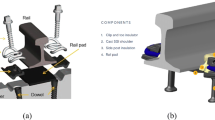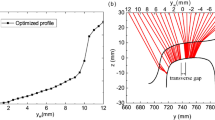Abstract
Rail wear is one of the main reasons for reducing the service life of high-speed railway turnouts in China. The rail wear characteristics of high-speed railway turnouts are influenced by a large number of input parameters of the complex train-turnout system. To reproduce the actual operation conditions of railway turnouts, random distributions of these inputs need to be considered in rail wear simulation. For a given nominal layout of the high-speed railway turnout, 19 input parameters for rail wear simulation in high-speed railway turnouts are investigated based on orthogonal design of experiment. Three dynamic responses (wheel−rail friction work, normal contact force and size of contact patch) are defined as observed values and the significant factors (direction of passage, axle load, running speed, friction coefficient, and wheel and rail profiles) are determined by two unreplicated saturated factorial design methods, including the half-normal probability plot method and Dong93 method. As part of the associated rail wear simulation, the influence of the wear models and the local elastic deformation on the rail wear was separately investigated. The calculation results for the wear models are quite different, especially for large creep mode. The local elastic deformation has a large effect on the sliding speed and rail wear and needs to be considered in the rail wear simulation.
Similar content being viewed by others
References
XU Jing-mang, WANG Ping, MA Xiao-chuan, XIAO Jie-ling, CHEN Rong. Comparison of calculation methods for wheel-switch rail normal and tangential contact [J]. Proceedings of the Institution of Mechanical Engineers, Part F: Journal of Rail and Rapid Transit, 2016, (DOI: 10.1177/ 0954409715624939)
LAGOS R F, ALONSO A, VINOLAS J. Development of a real-time wheel-rail contact model in NUCARS and application to diamond crossing and turnout design simulations [J]. Proceedings of the Institution of Mechanical Engineers, Part F: Journal of Rail and Rapid Transit, 2012, 226(6): 587–602.
SUN Y Q, COLE C, MCCLANACHAN M. The calculation of wheel impact force due to the interaction between vehicle and a turnout [J]. Proceedings of the Institution of Mechanical Engineers, Part F: Journal of Rail and Rapid Transit, 2010, 224(5): 391–403.
XU Jing-mang, WANG Ping. The investigation report on the damage of railway turnouts-field survey and measurement [R]. Chengdu: School of Civil Engineering, Southwest Jiaotong University, 2014. (in Chinese)
TUNNA J, SINCLAIR J, PEREZ J. A review of wheel wear and rolling contact fatigue [J]. Proceedings of the Institution of Mechanical Engineers, Part F: Journal of Rail and Rapid Transit, 2007, 221(2): 271–289.
SZABÓ A, ZOBORY I. On deterministic and stochastic simulation of wheel and rail profile wear process [J]. Periodica Polytechnica: Transportation Engineering, 1998, 26(1, 2): 3–17.
JENDEL T. Prediction of wheel profile wear-comparisons with field measurements [J]. Wear, 2002, 253(1, 2): 89–99.
ORVNÄS A. Simulation of rail wear on the Swedish light rail line tvärbanan [D]. Stockholm: Department of Aeronautical and Vehicle Engineering, Royal Institute of Technology (KTH), 2005.
ENBLOM R, BERG M. Simulation of railway wheel profile development due to wear-influence of disc braking and contact environment [J]. Wear, 2005, 258(1, 2): 1055–1063.
ENBLOM R, BERG M. Proposed procedure and trial simulation of rail profile evolution due to uniform wear [J]. Proceedings of the Institution of Mechanical Engineers, Part F: Journal of Rail and Rapid Transit, 2008, 222(1): 15–25.
BRAGHIN F, LEWIS R, DWYER R S. A mathematical model to predict railway wheel profile evolution due to wear [J]. Wear, 2006, 261(11, 12): 1253–1264.
JIN Xue-song, WEN Ze-feng, XIAO Xin-biao, ZHOU Zhong-rong. A numerical method for prediction of curved rail wear [J]. Multibody System Dynamics, 2007, 18(4): 531–557.
AUCIELLO J, IGNESTI M, MALVEZZI M, MELI E, RINDI A. Development and validation of a wear model for the analysis of the wheel profile evolution in railway vehicles [J]. Vehicle System Dynamics, 2012, 50(11): 1707–1734.
DING Jun-jun, LI Fu, HUANG Yun-hua, SUN Shu-lei, ZHANG Li-xia. Application of the semi-Hertzian method to the prediction of wheel wear in heavy haul freight car [J]. Wear, 2014, 314(1, 2): 104–110.
WANG Pu, GAO Liang. Numerical simulation of wheel wear evolution for heavy haul railway [J]. Journal of Central South University, 2015, 22(1): 196–207.
HAN Peng, ZHANG Wei-hua, LI Yan. Wear characteristics and prediction of wheel profiles in high-speed trains [J]. Journal of Central South University, 2015, 22(8): 3232–3238.
JOHANSSON A, PALSSON A B, EKH M, NIELSEN J C, ANDER M K, BROUZOULIS J, KASSA E. Simulation of wheel-rail contact and damage in switches &crossings [J]. Wear, 2011, 271(1, 2): 472–481.
NICHLISCH D, KASSA E, NIELSEN J, EKH M, IWNICKI S. Geometry and stiffness optimization for switches and crossings, and simulation of material degradation [J]. Proceedings of the Institution of Mechanical Engineers, Part F: Journal of Rail and Rapid Transit, 2010, 224(4): 279–292.
KASSA E, NIELSEN J C O. Stochastic analysis of dynamic interaction between train and railway turnout [J]. Vehicle System Dynamics, 2008, 46 (5): 429–449.
ENBLOM R. Deterioration mechanisms in the wheel–rail interface with focus on wear prediction: A literature review [J]. Vehicle System Dynamics, 2009, 47 (6): 661–700.
ARCHARD J F. Contact and rubbing of flat surfaces [J]. Journal of Applied Physics, 1953, 24(8): 981–988.
ZOBORY I. Prediction of wheel/rail profile wear [J]. Vehicle System Dynamics, 1997, 28(2): 221–259.
HOU Shu-juan, DONG Duo, REN Li-li, HAN Xu. Multivariable crashworthiness optimization of vehicle body by unreplicated saturated factorial design [J]. Structural and Multidisciplinary Optimization, 2012, 46(6): 891–905.
CHEN Ying, KUNERT J. A new quantitative method for analyzing unreplicated factorial designs [J]. Biometrical Journal, 2004, 46(1): 125–140.
DANIEL C. Use of Half-normal plots in interpreting factorial two-level experiments [J]. Technometrics, 1959, 4(1): 311–341.
ZAHN D A. An empirical study of the half-normal plot [J]. Technometrics, 1975, 17(2): 201–211.
DONG F. On the identification of active contrasts in unreplicated fractional factorials [J]. Statist. Sinica, 1993, 37(l): 209–217.
XU Jing-mang, WANG Ping, WANG Li, CHENG Rong. Effects of profile wear on wheel-rail contact conditions and dynamic interaction of vehicle and turnout [J]. Advances in Mechanical Engineering, 2016, 8(1): 1–14.
Author information
Authors and Affiliations
Corresponding author
Additional information
Foundation item: Projects(51425804, 51378439, 51608459) supported by the National Natural Science Foundation of China; Projects(U1334203, U1234201) supported by the Key Project of the China’s High-Speed Railway United Fund; Project(2016M590898) supported by China Postdoctoral Science Foundation; Project(2014GZ0009) supported by Sichuan Provinial Science and Technology support Program, China
Rights and permissions
About this article
Cite this article
Xu, Jm., Wang, P., Ma, Xc. et al. Parameters studies for rail wear in high-speed railway turnouts by unreplicated saturated factorial design. J. Cent. South Univ. 24, 988–1001 (2017). https://doi.org/10.1007/s11771-017-3501-1
Received:
Accepted:
Published:
Issue Date:
DOI: https://doi.org/10.1007/s11771-017-3501-1




